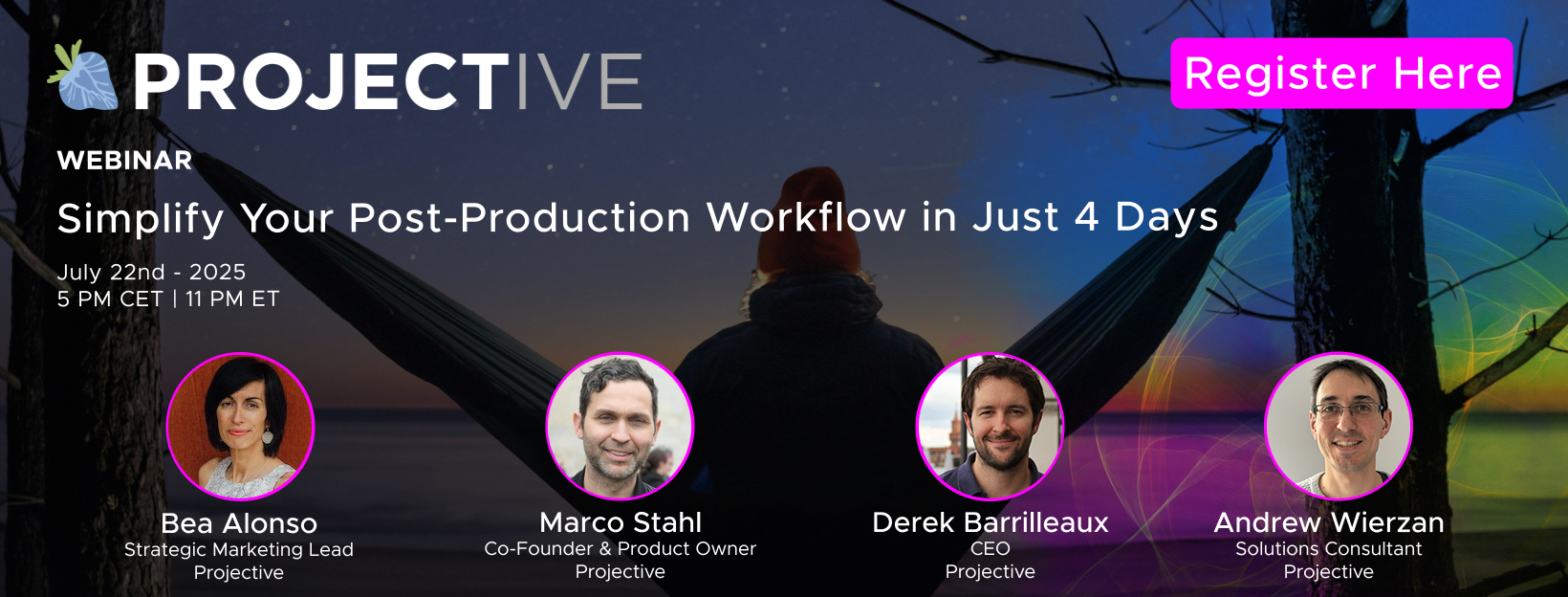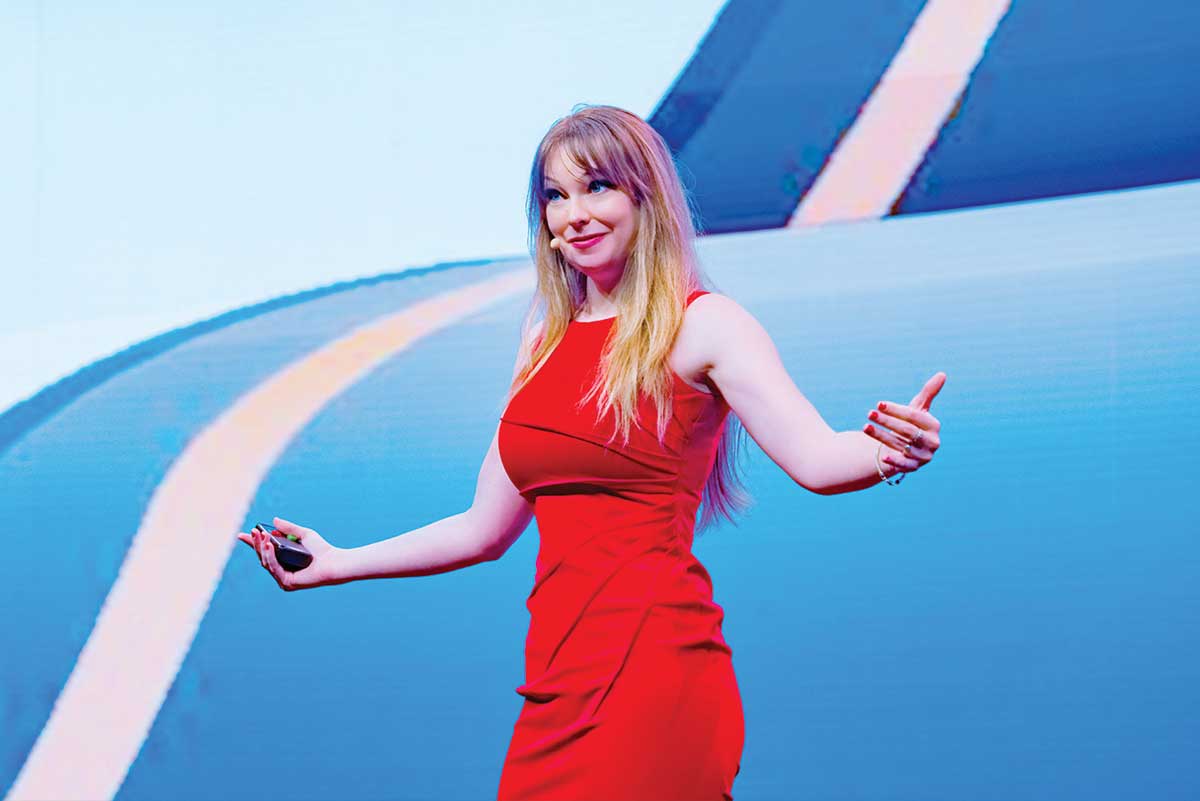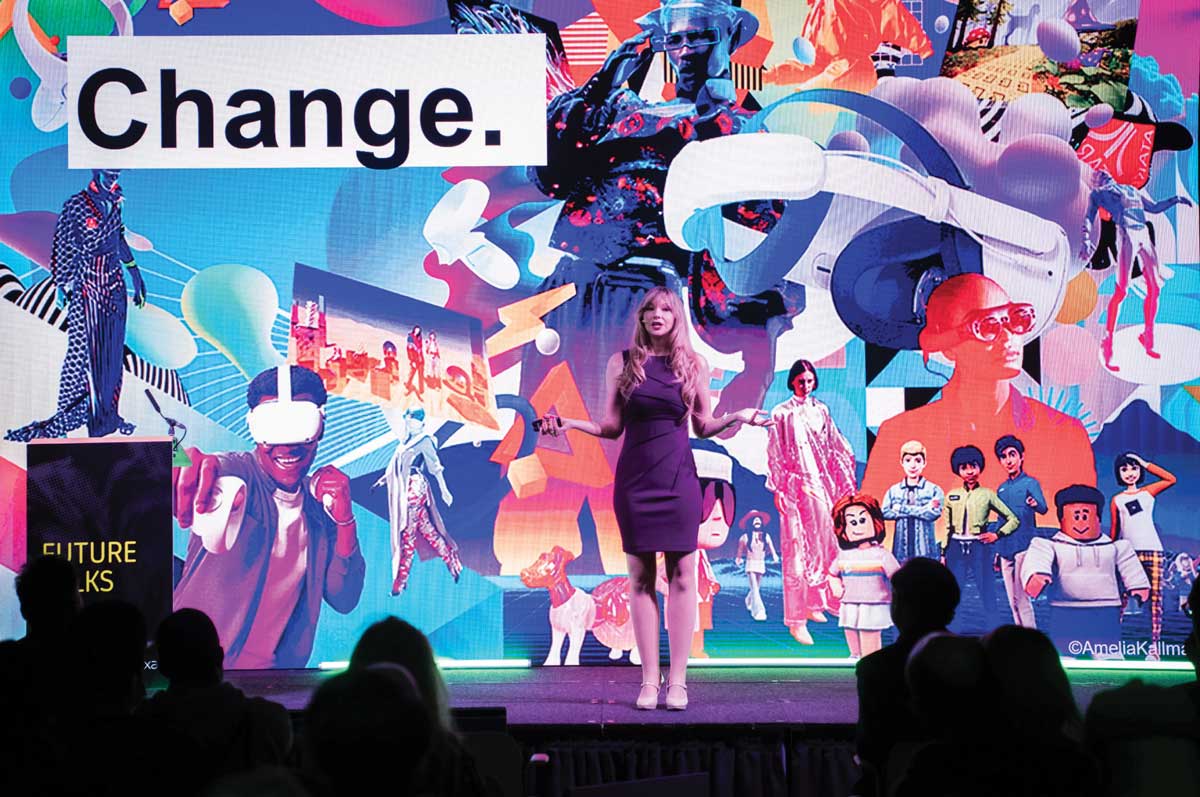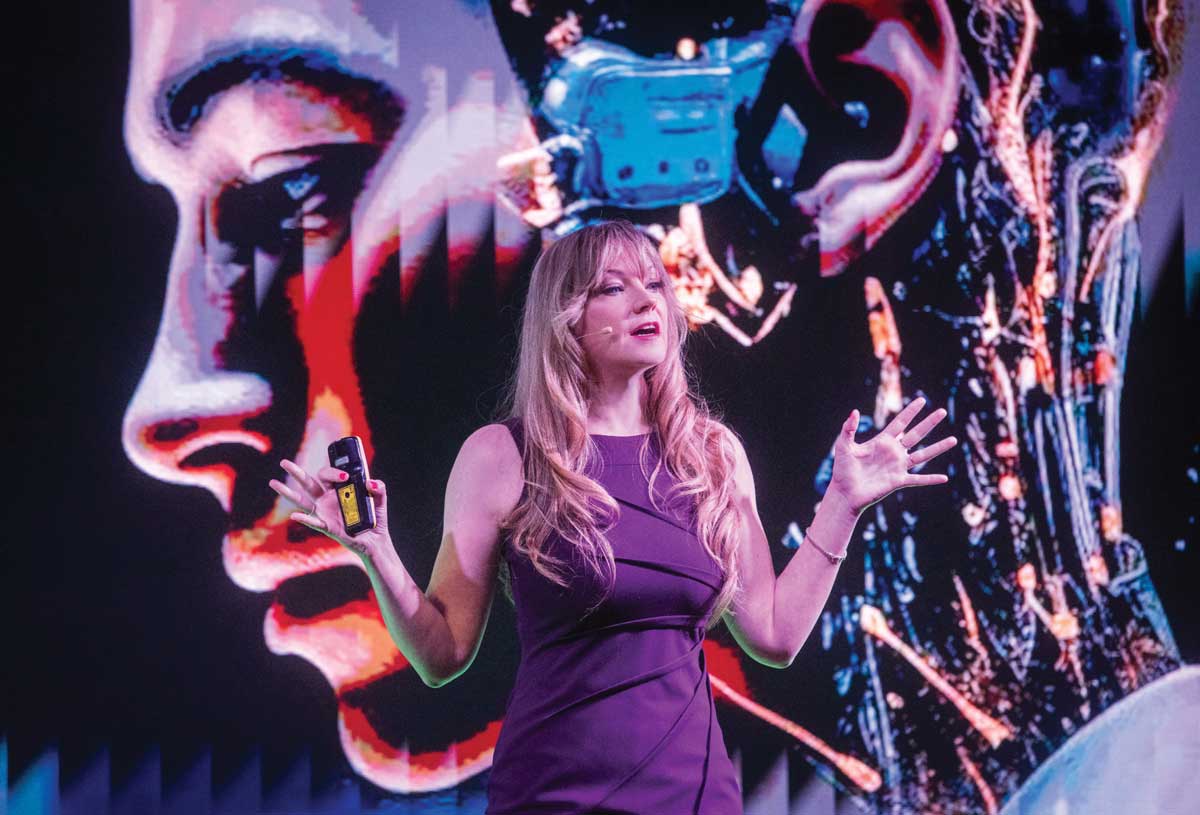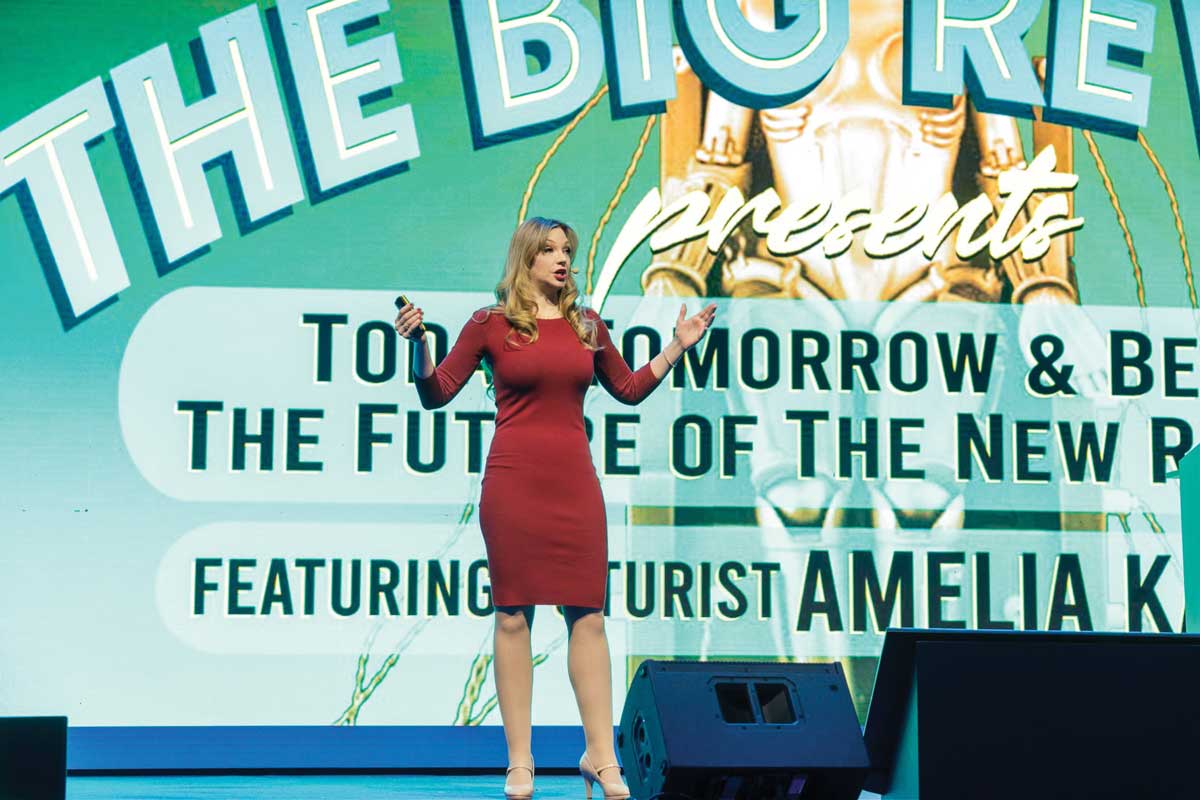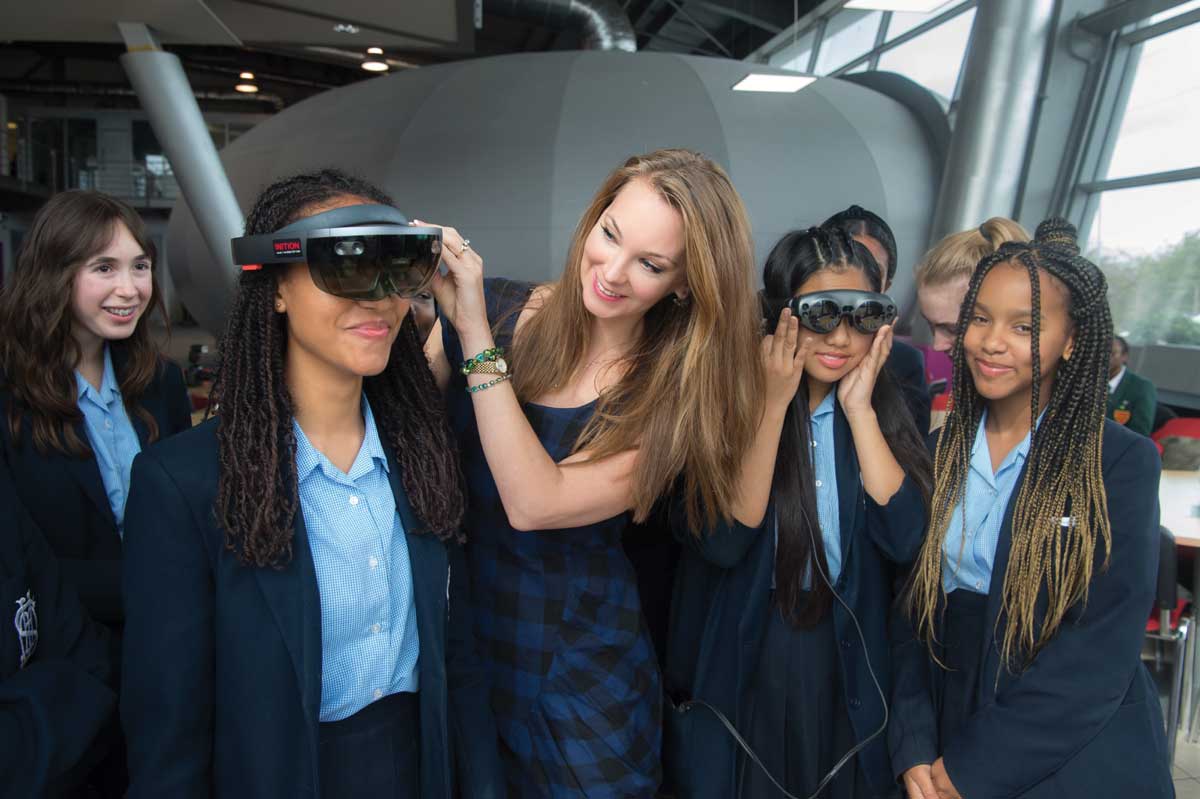Genius Interview: Amelia Kallman
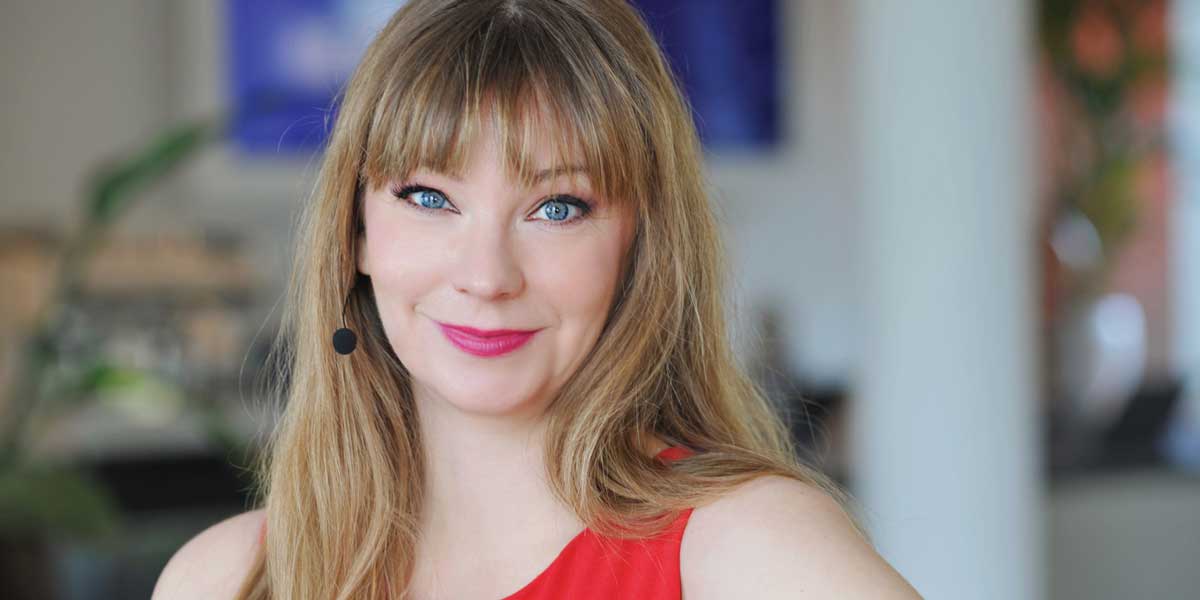
Posted on May 14, 2024 by FEED Staff
Recently named one of the ‘top 25 women in the metaverse’, the industry spokesperson Amelia Kallman helps both businesses and individuals keep their heads above water. A leading London futurist, speaker and author, Amelia consults brands, agencies and governments on the future of business and our lives. She hosts the podcast XR Star, as well as the YouTube series Blockchain in the Metaverse, with her writing often featured in Wired UK, IBC 365 and The Big Reveal.
FEED: Can you start by telling us what you do, and what led you to where you are now?
AMELIA KALLMAN: As a futurist, it’s my job to know about the latest up-and-coming technologies and their potential impact on the future of business, as well as the future of our lives.
I’ve been an independent futurist for seven years now.
I started in the tech industry over a decade ago;I mainly joined this space because, like anyone else, I needed a job! I talked my way into an assistant marketing role at a creative technology agency.
It was there I found that I had a real curiosity for being on the cutting edge of technology, and enthusiasm for what’s new and what’s next.
It’s really exciting to me to keep being challenged. I worked my way up and became their global head of innovation, opening up innovation labs in London, Dubai and Scotland for some of the biggest consultancies in the world.
Then, in 2017 I went independent. Part of the reason for that was I felt lots of people are so technical when explaining things, making it really hard to understand what they’re saying.
There are also people who are constantly trying to market and sell you things.
As an independent futurist, I can be completely honest and transparent about my assessments of technologies.
Essentially, I work with clients to help them navigate, anticipate and strategise for the coming changes and challenges. I believe I have a talent for making the complex accessible.
FEED: What have you learnt during your time as a futurist?
I’m often seen speaking on these technologies, hosting workshops and writing reports and articles – that kind of thing.
Behind the scenes, I’m constantly researching, reading, listening, asking questions and sifting through the massive amounts of hype and hyperbole, to identify patterns and themes and the emerging opportunities as well as the potential risks.
I have learnt a lot about myself. I love that my job is always new – it’s never finished and there is always something to learn.
There are always different opinions and viewpoints to explore. I also spend a lot of time speaking at events, sharing my research and insights.
I grew up on a stage, but back then I always had a character and a script, now it’s just me and that is quite terrifying even now.
Nevertheless, I love being in a job where I’m always taking risks – it keeps it exciting.
FEED: You have been named as one of the ‘top 25 women in the metaverse’. How do you define the metaverse, and what is its impact?
Quite simply, our 2D internet is becoming 3D – more spatial, immersive, persistent and social.
There are two common definitions of metaverse: the first says there’s only one metaverse and it features interoperability, the ability to go between different sites as easily as we go between websites today.
By this definition, the metaverse does not exist yet, and won’t for quite a long time. However, a second and more common use of the word has entered our vernacular: that is to talk about the 3D, immersive and social gaming worlds that exist today.
These are places Gen Z and Gen Alpha are already going to for entertainment and social experiences.
Then you have enterprises getting into this space, forming an industrial metaverse, which is a 3D digital copy of a real-world, physical place like a factory, city or supply chain that’s driven by real-time sensors and data.
This allows businesses to trial and test scenarios and products before implementing them inside the physical world.
We are at a really interesting place with these technologies: moving everyone in this direction will require us to increase our computing, processing and networking power, which also means we need to increase our energy because we are essentially moving from 2D to 3D.
We are moving our data, too, and creating all that complex data creates a greater footprint.
This year, I think we’re going to see a major breakthrough when it comes to populating the spatial internet.
That’s going to come at the convergence of generative AI. Today, we can input text and speech and images to get a 2D output.
Very soon we’re going to be able to input text and speech and images to get a 3D output.
We’re already seeing signs of this from gaming metaverses like Roblox.
We know that Nvidia, the largest AI chip manufacturer, has teamed up with WPP, the world’s largest advertising agency, to come up with a 3D design ecosystem.
We can expect this to be a really big breakthrough: it will mean that anybody has the ability to start populating the spatial internet without needing to know how to code.
This is also going to be a very vulnerable year, because we have a gap in regulation and policy.
It’s a year where 49% of the world’s population have the opportunity to vote across at least 64 countries.
You take the fact that these technologies that disrupted previous election cycles have matured, people have gotten better at using them and the cost of content creation and distribution has gone down, while loneliness and isolation has gone up.
You couple that with this gap in policy, and we’re looking at our most vulnerable election cycle yet.
FEED: You specialise in identifying the opportunities and risks of AI and XR technologies. Could you share some of these with us?
With the opportunities and risks of AI, we’ve heard a lot about efficiencies and productivity.
To quantify that, MIT have recently done a study where they empowered customer-service workers with AI assistants, and they found that they became 14% more productive.
It also meant that people who only had two months’ worth of experience became equal with those who had six.
Looking at this kind of instant upskilling could redefine what entry-level positions look like.
One of the trends we’re going to start to see this year is large language models embedded into our chatbots and smart home speakers, which will allow them to fulfil their original intention: to become a new sales and marketing channel.
By the end of this year, I might be able to say to my smart home speaker: ‘I want to go on holiday. These are the four days I have; this is my budget. I want to get there by train and I want to go to the seaside. I want to go someplace where the weather’s nice and it must be dog friendly.’ Not only will the speaker be able to make recommendations based on my preferences, but I’ll also be able to say ‘I like the sound of that’, and have it book everything for me.
We will see the customer journey and experience accelerate and become more personalised.
When it comes to things like supply chain, it’s fascinating: we can take AI we have already implemented, with computer vision and deep learning, and add large language models which can turn any physical environment into an employee.
I could ask it for daily summaries or reports, or even make suggestions on how to improve efficiencies.
It will be able to automate corrective behaviour.
If there’s a problem in the factory, shipping container or warehouse, for example, this can automate changes on the front end of an e-commerce site or a retail environment.
I think we’re also going to see more adaptive products and marketing campaigns as a result.
FEED: Generation Alpha are second- wave digital natives. Could you share some thoughts on how you think businesses will evolve as they get older?
By 2030, 58% of the workforce will be made up of Gen Z and Millennials. Gen Alpha will be entering the workforce and will have the largest ever population of people over 60, many of whom will still be working.
Right now, 59% of experts believe we will continue to see a move towards remote and hybrid working.
We’re looking at having the most disparate workforce ever, with various levels of experience, different expectations, located in different places around the world.
Companies are going to need new ways to bring people together, not just for things like training, ideation, designing and collaboration, but also to create a sense of community and camaraderie and culture that’s going to be so important in retaining talent moving forward.
These last couple of years, we’ve seen the pitfalls of physical working and the downfalls of digital working.
By introducing virtual XR and creating a meta hybrid workforce, I think we are going to see some of those frictions and frustrations alleviated while discovering new benefits, being able to bring people together who are in a room and remote in a way that is impactful, immersive and memorable.
I also think this could help alleviate some unconscious biases we have around people’s age and experience when we move into an avatars scenario.
FEED: Though of course there are positives, there’s a lot of fear surrounding AI. What would you say to people with these concerns?
Number one, I would say it’s a very natural instinct to have, and probably a good instinct to not fully accept everything that’s been thrown at us.
Number two, I would say don’t underestimate the fact that we are so exposed right now.
Every time we pick up our phone, every time we go into our email or onto the news, we’re inundated with updates saying AI is the end of the world.
But that is partly because the algorithms have recognised that, if they can create an emotional response out of us, we tend to click through and pay attention.
That allows them to manipulate us into giving them even more of our time, attention and money.
So yes, things are moving fast, but because these are powerful technologies, all these incremental updates feel like they are quite big.
Another thing we need to be talking about more is the environmental impact.
It’s incredibly important to recognise that, through all these new technologies, we are creating massive amounts of new data, and data has a carbon footprint.
This year, it’s expected we are going to see between 80 and 130 million generative AI tasks performed every hour in enterprise in the US alone. Every single one of those tasks already uses four to five times more energy than a simple Google search.
As these tasks become more complex, the amount of energy it takes increases.
While I believe that AI is going to help us to solve issues surrounding the climate crisis, we have to be fully aware of how we are also contributing to it.
This leads to another technology that I think we should be talking about right now: quantum computing. I know, when you say quantum, a lot of people’s eyes just glaze over.
But you don’t have to understand how it works to understand how game changing it will be.
We’re talking about creating massive amounts of data. Quantum is going to be able to crunch this data very fast for instant analysis. This is essentially going to facilitate computing going from 2D to 3D.
Quantum computing crunches protons and neutrons and electrons – moving us into multi-dimensional capabilities. This is expected to be with us by the end of this decade.
It’s going to be able to help us solve the climate crisis, cure diseases, probably expand our lifespans and make things like holographic technologies come into play.
There will also be risks as there are with any technology.
The encryption we rely on today means nothing to these computers as they’ll be able to break it. In the industry, we’re already talking about this idea of Q-day, which is a bit like a Y2K kind of panic.
This is something we can start preparing for.
I hope that, by talking about this, we can learn from how reactive we’ve been around AI and start to be proactive around this groundbreaking, game-changing technology that is coming our way faster than a lot of people anticipate.
FEED: How should businesses approach the implementation of AI?
In 2023, we saw a big focus on these AI models.
This year, we are going to have focus on the ingredients that go into these models, which is the data.
We talk about how AI is going to take away a lot of jobs, but this is one area where it’s going to create an entirely new industry.
The World Economic Forum have projected that, within the next two years, AI could augment or replace 85 million jobs.
They predict that it will create 97 million new opportunities, but this means reskilling 40% of the workforce, which is 1.4 billion people over the next three years.
For companies, we have to be really aware of the human psychological impact that working with AI has.
There are already early studies to show that people who take the most pride in their work are the most negatively impacted by working with AI, because it’s like it takes away a part of their identity or a sense of self, which then has a negative impact on their performance.
What this means for leadership is that they need to expand their skills because we’re actually looking at how we can help people cope with really big changes.
There’s a lot of fear and resistance right now because people no longer have a clear vision of their trajectory or their career.
Managers are also resistant to reskilling and retraining their talent because they’re afraid of losing them.
Leadership have to make sure that, as we’re asking people to change, they see this as an opportunity for growth and development, understanding that this is going to increase their value to the company, and that they still have a place in that future.
It’s a pretty big task we have moving into this time and I don’t think we can underestimate the resistance we’re going to meet when it comes to integrating these technologies into the future.
This genius interview was first published in the Spring 2024 issue of FEED.


